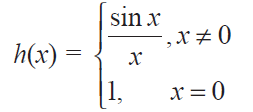HOW TO TEST IF THE GIVEN FUNCTION HAS REMOVABLE DISCONTINUITY
The function f(x) is defined at all points of the real line except x = 0. That is, f(0) is undefined, but lim x -> 0 sin x/x = 1. If we redefine the function f(x) as

h is defined at all points of the real line including x = 0. Moreover, h is continuous at x = 0 since
lim x -> 0 h(x) = lim x -> 0 (sin x / x) = 1 = h(0)
Note that h(x) = f(x) for all x ≠ 0. Even though the original function f(x) fails to be continuous at x = 0, the redefined function became continuous at 0.
That is, we could remove the discontinuity by redefining the function. Such discontinuous points are called removable discontinuities. This example leads us to have the following.
Definition of removable discontinuity :
A function f defined on an interval I ⊆ R is said to have removable discontinuity at x0 ∈ I if there is a function h :
I -> R such that h(x) =

Finding Removable Discontinuity At the given point - Examples
Question 1 :
Which of the following functions f has a removable discontinuity at x = x0? If the discontinuity is removable, find a function g that agrees with f for x ≠ x0 and is continuous on R.
(i) f(x) = (x2 - 2x - 8)/(x + 2), x0 = -2
Solution :
In order to check if the given function is continuous at the point x0 = -2, let us apply -2
f(x) = ((-2)2 - 2(-2) - 8)/(-2 + 2),
= (4+4-8)/0
= 0/0
The given function is not continuous at x = -2. In order to redefine the function, we have to simplify f(x).
f(x) = (x2 - 2x - 8)/(x + 2)
= (x - 4) (x - 2)/(x - 2)
f(x) = (x - 4)
f(-2) = -2 - 4
= -6
Hence the given function has removable discontinuity at x = 2.
By redefining the function, we get

Kindly mail your feedback to v4formath@gmail.com
We always appreciate your feedback.
©All rights reserved. onlinemath4all.com
Recent Articles
-
Digital SAT Math Problems and Solutions (Part - 150)
Apr 25, 25 11:46 AM
Digital SAT Math Problems and Solutions (Part - 150) -
AP Calculus AB Problems with Solutions (Part - 19)
Apr 24, 25 11:10 PM
AP Calculus AB Problems with Solutions (Part - 19) -
AP Calculus AB Problems with Solutions (Part - 18)
Apr 24, 25 11:06 PM
AP Calculus AB Problems with Solutions (Part - 18)
